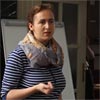Teaching with Testimony Enters Second Year in Czech Republic

USC Shoah Foundation recently convened its second Teaching with Testimony for the 21st Century seminar in the Czech Republic. Held July 8-12 at the Malach Center for Visual History in Prague, the program attracted educators from throughout the country and also from neighboring Slovakia.
The positive response among participants was overwhelming, as they armed themselves with techniques and materials to use the lessons of the Holocaust to combat contemporary forms of racism. At the conclusion of the seminar, the 2012 graduates of the program shared their experiences and inspiration with this year’s participants. The graduates also presented their own original educational materials, created as a result of Teaching with Testimony, at a follow-up event. Covering topics from the rise of Nazism to the Rwandan Tutsi genocide, their work demonstrates the range of creative teaching made possible by USC Shoah Foundation.
- Josef Märc, from Gymnázium Chomutov, shared his modular “Arrivals of Jaroslav Kraus,” which examines several witnesses’ descriptions of their arrivals at new locations, analyzing the contexts and meaning of memories shared.
- The lessons developed by Kateřina Kršková, from Manažerská Akademie in Jihlava, address the search for identity and the results of anti-Jewish legislation in the regional context, focusing on barriers between the Czech and German populations—and the effects on those labeled as Jews.
- From Gymnázium Plzeň, Monika Stehlíková’s “I Do Take It On” plays on the phrase that can mean either “taking responsibility for something” or “wearing something.” Her lesson draws from testimonies of survivors of the Holocaust and the Rwandan genocide to investigate issues of responsibility through the metaphor of wearing one’s statements.
- Renáta Havelková, from SPŠS in Olomouc, documents the life of Czech writer Ota Pavel, as remembered by his brothers Hugo and Jiří, in a set of lessons that also connect to literature and film.
- Monika Badejová, from SPdgŠ and SZŠ sv. Anežky České in Odry, created three lessons based on one survivor’s testimony and the ramifications of racist legislation: “Postal service” examines the connection through the mail between Terezín ghetto residents and relatives outside; “Pupils-Non-pupils” relates the gradual ejection of children labeled as Jews from all educational institutions; and the third lesson looks at Czech racism in the past and today.
- Marcel Mahdal, from Gymnázium of Pavel Tigrid and collaborator at the Civic Association PANT in Ostrava, wrote “London Calling,” focusing on the Czech emigré experience in wartime England and the BBC broadcasts to occupied Bohemia and Moravia.
- Julie Jenšovská, of the Jewish Museum of Prague, created the multifaceted “International Committee of the Red Cross and Terezín,” which analyzes the role of international humanitarian organizations. The lesson is designed for use within the national educational project “Ours or Foreigners? Jews in the Czech 20th Century.”
- Tereza Vodičková, from SOŠ and SOU BEAN, in Prague, built a set of lessons based on readings of literature and viewings of testimonies entitled “Lamentations,” named for Czech author Jiří Weil’s “Lamentations for 77297 victims.”
- From Gymnázium Sokolov, Vladimír Rozhon’s “End of the WWII in Sokolov (Falkenau) Region” focuses on Nazism in the territory, from its rise through the end of the war, when death marches crisscrossed the region.
- Markéta Hummlová, from Obchodní Akademie, examines the perception of history, social memory, and the role of testimony in “Me and the 20th Century.”
- From Gymnázium Jeseník, Tomáš Svoboda’s “Journeys of Czechoslovak Jews Between the Czechs and the Germans” employs the testimony of Alice Hrbková to illustrate differences between official political history and people’s actual lives.
USC Shoah Foundation’s flagship professional development initiative, Teaching with Testimony is a two-year program that incorporates workshops, mentoring, and community building to prepare educators to search for and utilize testimony from the Visual History Archive, as well as digital learning tools such as IWitness.